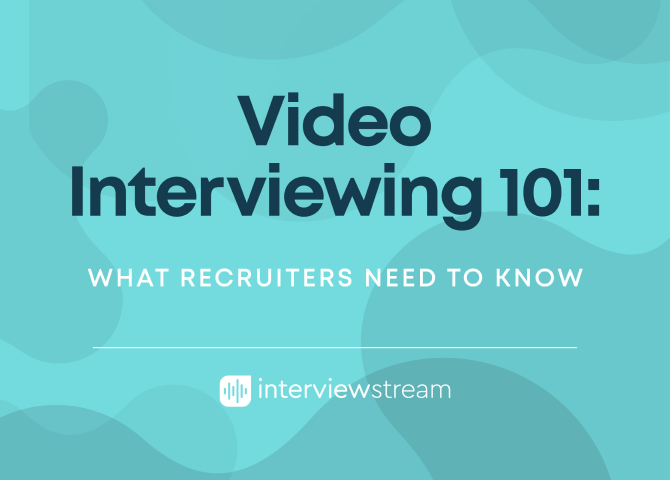2022 Workforce Projections for Every Industry

The rundown
- Backfilling fallout from the Great Resignation will have businesses across sectors getting creative with hiring practices. Many will rehire boomerang employees or embrace the gig economy.
- People leaders should consider upskilling (or reskilling) current employees to fill crucial openings and build loyalty among their workforce, as well as hiring “imperfect” candidates with an expectation for on-the-job training whenever possible.
- As the pandemic continues to ebb, with workplace safety considerations still evolving, maintaining flexibility with remote work — and a proactive, compassionate HR strategy — will continue to be essential for attracting and retaining talent.
Table of contents
- Hiring and Recruitment in 2022: What to Expect
- K12 Education
- Higher Education
- Finance
- Government
- Healthcare
- Insurance
- Manufacturing
- Retail
- Staffing & Recruiting
- Technology
- Final Thoughts
- About interviewstream
Hiring and Recruitment in 2022: What to Expect
Two years after COVID-19 first rocked global communities, moving into 2022 we’ll still be feeling its effects. But how will the pandemic affect your recruiting for this year?
As you’ve probably read dozens (or hundreds?) of times by now, we can be confident that hybrid and remote work models won’t be going away anytime soon. Gartner predicts that 31% of all workers worldwide will be at least partially remote; in particular, 53% of the American workforce will be remote. If remote work is an option for your industry and this is a pill you haven’t swallowed yet, it’s time to get serious about it. Otherwise, expect to lose talent to more flexible competitors.
Across industries, the Great Resignation took hold in 2021, leaving many employers with open jobs and a tough time recruiting new talent to fill them. Though resignation rates may slow down in 2022, businesses will still need to play catch-up on the fallout. This will entail getting creative in your recruiting efforts, finetuning your benefits offerings, and upskilling your existing workforce.
Read on for predictions and tips in specific industries.
Interested in our HR newsletter? Sign up below!
Sign up for our newsletter – we send out a newsletter email two to four times a year which includes HR trends, industry-relevant knowledge, and the latest interviewing tips for recruiters and candidates.
K12 Education
There are lingering concerns about an ongoing teacher shortage heading into 2022, as hiring trends for K12 teachers and staff have rebounded but applicants remained low in 2021.
Additionally, teachers continue to face high expectations for adapting to unusual circumstances — including ongoing pandemic responses like quarantines and remote teaching for some vulnerable populations. However, they also face the challenges of optimizing and streamlining the use of edtech to connect parents, students, and teachers, increased emphasis on school climate and culture, and the growing importance of school choice.
Projection: It’s a good time to focus on hiring new teachers, rather than experienced applicants, where possible — largely because experienced teachers are in extraordinarily high demand and short supply. However, there’s also a benefit for schools: the technological innovation now required for the job may come naturally to those new to the career.

Higher Education
Perhaps more than ever, the value of a college education is in doubt among Americans. Many cite the prevalence of online learning as a significant strike against this perceived value compared to its costs. As a result, colleges and universities across the country are fighting to adapt to the new normal and increase enrollment.
Fortunately, the news isn’t all bad. After major cuts during the height of the pandemic, there’s good reason to be optimistic about funding in higher education for 2022. And that means institutions may have a chance to revisit their staffing options and recruit new talent to help boost the value of their offerings to incoming students.
Projection: Higher learning institutions will need to get creative to attract students and tell a unique story about what benefits and experiences they can offer their graduates. The same will be true of attracting talent if the dollars are available to do so — and backfilling critical teaching and administrative roles that will reduce class sizes and support instructors’ creativity is a smart place to start.
Finance
The global financial services market is seeing a huge surge in competition of late, with new tech-based solutions coming out all the time to challenge incumbent providers. The result has been a big move toward digital transformation across the space, with organizations pursuing innovative ways to manage data, support customers, and enable employees to work productively.
This is a positive trend, and it’s one every financial services institution should aim to join. Keeping up with challengers — and retaining talent that might easily be tempted away by more tech-savvy companies — with an eye for innovation is an essential way to stay competitive. It’s also majorly appealing to customers.
Projection: Investing in tech that will save time and money across organizational functions is a simple, forward-thinking way to conduct business, enable growth, and keep employees engaged. More financial services firms are moving to the cloud for everything from demand generation to hiring practices — and seeing results.
Government
As is often the case in election years, the pace of government hiring — at least at the federal level — is largely unknown for 2022. A lot hinges upon what budget and policies are approved in the legislature. What we do know is that government hiring in 2021 was on an uptick compared to 2020 — but remained slower than previous years.
At the local level, with a booming real estate market hopefully bringing in more tax revenue for communities across the country, the potential for growth looks good.
But attracting talent to the public sector requires an emphasis on making a positive impact and a welcoming atmosphere, particularly in these politically fraught times.
Projection: Regardless of the volume of hiring in government for 2022, operating principles in the public sector are becoming ever-more digitized as agencies seek to save money and reduce overhead on bulky solutions and manual workflows. Recruiters should be ready to align with these priorities — and cast a wide net for applicants — by leveraging the right tools for the job.
Healthcare
The healthcare worker shortage has had a severe impact on the industry across the country. Hundreds of thousands of unfilled positions has led to hospitals tightening service offerings, shutting down practices, and more.
Organizations can adapt to current trends and compete in this difficult talent market by developing and highlighting an appealing brand and culture; hiring part-time and on-call staff to fill in gaps and help take the load off of full-time employees without overspending; and offering better benefits than their competition.
Such benefits could include higher pay, more time off with more consistent schedules, and, perhaps more important than anything else, prioritizing the safety of their employees. Focus on this area is likely to increase in the coming years.
Projection: Virtual recruiting is a critical factor in extending healthcare organizations’ reach across a limited talent pool. Remote interviewing and hiring processes can reduce the time it takes to fill an open role, and healthcare recruiters will be well-served to grow this capability in 2022. More professionals may be returning to work (or entering the workforce for the first time), and broad reach, as well as good benefits and a welcoming culture, will ensure a competitive advantage in bringing them on board.
“Hospitals need to rethink their recruitment strategies and incorporate time-saving technology into their recruiting plans.”
Insurance
A recent study showed that 93% of insurance provider respondents plan to increase or maintain their headcounts heading into 2022. That’s good news — growth is steady and secure. The bad news, of course, is that the study also indicated that every functional area is considered difficult to fill in the current climate.
Insurance is a niche space, and with a talent shortage in place across sectors, it’s tough to compete for applicants. However, turnover rates are exceptionally high among industries that foster skills which may be very relevant to a career in insurance — for example, finance (data-driven decision making) and technology (customer service and innovation). This could present an opportunity for insurers to recruit based on potential rather than simply the number of years of experience.
Projection: To confront these challenges, insurers can attract new recruits by setting aside notions of the “perfect” candidate. Instead of seeking perfectly qualified applicants, hiring managers should consider bringing in new folks looking to make a change from tangential industries — such as finance or tech — and offering on-the-job training. This can help boost loyalty and widen applicant pools with strong results.
Manufacturing
After a serious dip in growth during 2020, the manufacturing industry saw their growth increase by 12% in the first quarter of 2021. Still, news of shortages continues in many manufacturing spaces — both of goods and workers.
Supply chain interruptions and port delays may have an impact on the industry’s ability to deliver goods to consumers, but so does a lack of workers. Automation, while growing and offering an important solution to some of the disruption risks uncovered since 2020, isn’t covering the deficit. This means manufacturers are being forced to increase pay and benefits to fill job openings.
Projection: Increased pay and benefits, as well as providing on-the-job training to willing but inexperienced applicants, can help manufacturers fill jobs moving into 2022. Another key strategy will be recruiting from afar via flexible platforms, offering relocation bonuses where necessary, to increase talent pools and bring fresh perspectives to their workforces.

Retail
One of the hardest-hit industries in the worker shortage crisis, retailers and foodservice companies are still struggling to meet the demand for their goods with a significant lack of help. This is despite record-high wages and the introduction of new benefits, such as education support and even childcare programs.
The resolution to this crisis may shake out in any number of ways — from permanently higher pay and benefits, to temporary bonuses and perks, or anything in between. But what rings true for now is a demand for compassion, flexibility, and authenticity. Job seekers know they have the upper hand in today’s market, and won’t be fooled by simple hiring bonuses or slightly higher starting wages offered instead of lasting benefits and flexibility from potential employers.
Projection: It remains to be seen whether the current labor shortage will result in significant, permanent change to low-wage working standards, or fade out as individuals feel increased pressure to return to work over the next year. In either case, creative, compassionate perks and increased pay will put retailers on an even playing field with competitors for attracting potential applicants — and flexible recruiting practices may offer an additional advantage.
Staffing & Recruiting
Recruiters are thriving in an economy beset by talent shortages and increased hiring needs across industries. But some are coming out on top.
These include the tech-savvy, proactive recruiters who take an omnichannel approach to find applicants, showcase attractive and welcoming company cultures and benefits, and those who specialize in distinct areas and niches.
Recruiters and staffing agencies who are prioritizing those skills are performing better and attracting more talent to fill open roles for their clients. Specialized recruiting in particular can also mean simpler onboarding and more loyalty – since a recruiter has the knowledge needed to spot a perfect fit long before the interviews start.
Projection: Expect the benefits of specialization and the use of technology to continue to shine for recruiters in 2022. Although the labor shortage may leave many industries wanting when it comes to open roles, savvy job seekers will see the potential of staffing and recruitment as a career path. Hiring managers should be ready to welcome them.

Technology
According to a Korn Ferry study, all analyzed countries except India will have a tech talent deficit by 2030 — resulting in as much as $162.25 billion in unrealized output by that year. Already, 9 out of 10 executives in this space reported higher-than-usual attrition in their organizations in a PwC study from August 2021.
Companies are compensating for this upheaval by continuing to offer remote and hybrid work options, honing in on creative benefits structures, prioritizing employees’ mental health, and putting extra (much needed) effort into developing talent among groups that are historically underrepresented in the tech ranks, such as women and minority populations.
As demand for new and better tech is only expected to grow for the foreseeable future, talent will always be at a premium — and employers will be expected to maintain these efforts to keep up.
Projection: Tech company leaders and recruiters have the advantage of many free and emerging resources to help train recruits on skills like using no-code/low-code solutions and simple programming languages. It will be wise for them to explore using these tools, as well as teaching their current workforce, and reskilling employees and training candidates from unconventional backgrounds.
Final Thoughts
If “new normal” and “unprecedented circumstances” were some of the themes in business strategizing during 2020 and 2021, 2022’s theme will absolutely include “talent shortage.” It’s a universal problem for hiring managers and recruiters these days — and when everyone’s competing for applicants, it’s tough to feel like we’re in this together.
However, the result may well be a leveled-up approach to recruiting and retaining talent for years to come. Put simply, you can’t go wrong with an authentic, extraordinary focus on the happiness and wellbeing of your employees — and investing in their happiness will sure to pay off as an investment in your organization’s success over time.
Want to learn more about video interviewing?
Chat with a client success expert today and learn how to leverage remote interviewing solutions to simplify and personalize your hiring practices.
About interviewstream
interviewstream is an industry leading recruiting software company that helps you reach your top candidates more effectively. Our customers have completed over 3 million interviews using interview builder, interview on demand, interview scheduler, interview connect – and we’d love to help you as well. Talk to an expert today to learn how to get started.
The interviewstream platform
Speak to an expert today to learn how our remote interviewing solutions make hiring more effective.
About interviewstream
As companies transition to remote work, we exists to help recruiters and hiring teams ask the right questions every time, screen candidates faster, make scheduling easier and reach candidates everywhere. Using our remote interviewing platform, your team will have a complete view of the candidate in one location while also leveraging one of the leading platforms for online interviewing.



